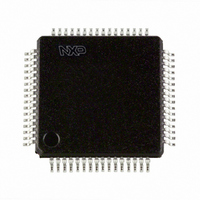LPC2141FBD64,151 NXP Semiconductors, LPC2141FBD64,151 Datasheet - Page 15

LPC2141FBD64,151
Manufacturer Part Number
LPC2141FBD64,151
Description
IC ARM7 MCU FLASH 32K 64LQFP
Manufacturer
NXP Semiconductors
Series
LPC2100r
Datasheet
1.LPC2141FBD64151.pdf
(40 pages)
Specifications of LPC2141FBD64,151
Program Memory Type
FLASH
Program Memory Size
32KB (32K x 8)
Package / Case
64-LQFP
Core Processor
ARM7
Core Size
16/32-Bit
Speed
60MHz
Connectivity
I²C, Microwire, SPI, SSI, SSP, UART/USART, USB
Peripherals
Brown-out Detect/Reset, POR, PWM, WDT
Number Of I /o
45
Ram Size
8K x 8
Voltage - Supply (vcc/vdd)
3 V ~ 3.6 V
Data Converters
A/D 6x10b
Oscillator Type
Internal
Operating Temperature
-40°C ~ 85°C
Processor Series
LPC21
Core
ARM7TDMI-S
Data Bus Width
16 bit, 32 bit
Data Ram Size
8 KB
Interface Type
SCI/UART/SPI/SSP/I2C/USB
Maximum Clock Frequency
60 MHz
Number Of Programmable I/os
45
Number Of Timers
2
Operating Supply Voltage
3.3 V
Maximum Operating Temperature
+ 85 C
Mounting Style
SMD/SMT
3rd Party Development Tools
MDK-ARM, RL-ARM, ULINK2
Minimum Operating Temperature
- 40 C
On-chip Adc
6-ch x 10-bit
Cpu Family
LPC2000
Device Core
ARM7TDMI-S
Device Core Size
16/32Bit
Frequency (max)
60MHz
Total Internal Ram Size
8KB
# I/os (max)
45
Number Of Timers - General Purpose
2
Operating Supply Voltage (typ)
3.3V
Operating Supply Voltage (max)
3.6V
Operating Supply Voltage (min)
3V
Instruction Set Architecture
RISC
Operating Temp Range
-40C to 85C
Operating Temperature Classification
Industrial
Mounting
Surface Mount
Pin Count
64
Package Type
LQFP
Package
64LQFP
Family Name
LPC2000
Maximum Speed
60 MHz
Lead Free Status / RoHS Status
Lead free / RoHS Compliant
For Use With
568-4310 - EVAL BOARD LPC2158 W/LCD568-4297 - BOARD EVAL LPC21XX MCB2100MCB2140UME - BOARD EVAL MCB2140 + ULINK-MEMCB2140U - BOARD EVAL MCB2140 + ULINK2MCB2140 - BOARD EVAL NXP LPC214X ARM FAM622-1005 - USB IN-CIRCUIT PROG ARM7 LPC2K568-2097 - BOARD EVAL FOR LPC214X ARM MCU
Eeprom Size
-
Lead Free Status / Rohs Status
Compliant
Other names
568-1761
935280015151
LPC2141FBD64-S
935280015151
LPC2141FBD64-S
Available stocks
Company
Part Number
Manufacturer
Quantity
Price
Company:
Part Number:
LPC2141FBD64,151
Manufacturer:
NXP Semiconductors
Quantity:
10 000
NXP Semiconductors
LPC2141_42_44_46_48_4
Product data sheet
6.5.1 Interrupt sources
6.5 Interrupt controller
6.6 Pin connect block
The Vectored Interrupt Controller (VIC) accepts all of the interrupt request inputs and
categorizes them as Fast Interrupt Request (FIQ), vectored Interrupt Request (IRQ), and
non-vectored IRQ as defined by programmable settings. The programmable assignment
scheme means that priorities of interrupts from the various peripherals can be dynamically
assigned and adjusted.
FIQ has the highest priority. If more than one request is assigned to FIQ, the VIC
combines the requests to produce the FIQ signal to the ARM processor. The fastest
possible FIQ latency is achieved when only one request is classified as FIQ, because then
the FIQ service routine does not need to branch into the interrupt service routine but can
run from the interrupt vector location. If more than one request is assigned to the FIQ
class, the FIQ service routine will read a word from the VIC that identifies which FIQ
source(s) is (are) requesting an interrupt.
Vectored IRQs have the middle priority. Sixteen of the interrupt requests can be assigned
to this category. Any of the interrupt requests can be assigned to any of the 16 vectored
IRQ slots, among which slot 0 has the highest priority and slot 15 has the lowest.
Non-vectored IRQs have the lowest priority.
The VIC combines the requests from all the vectored and non-vectored IRQs to produce
the IRQ signal to the ARM processor. The IRQ service routine can start by reading a
register from the VIC and jumping there. If any of the vectored IRQs are pending, the VIC
provides the address of the highest-priority requesting IRQs service routine, otherwise it
provides the address of a default routine that is shared by all the non-vectored IRQs. The
default routine can read another VIC register to see what IRQs are active.
Each peripheral device has one interrupt line connected to the Vectored Interrupt
Controller, but may have several internal interrupt flags. Individual interrupt flags may also
represent more than one interrupt source.
The pin connect block allows selected pins of the microcontroller to have more than one
function. Configuration registers control the multiplexers to allow connection between the
pin and the on chip peripherals. Peripherals should be connected to the appropriate pins
prior to being activated, and prior to any related interrupt(s) being enabled. Activity of any
enabled peripheral function that is not mapped to a related pin should be considered
undefined.
The Pin Control Module with its pin select registers defines the functionality of the
microcontroller in a given hardware environment.
After reset all pins of Port 0 and Port 1 are configured as input with the following
exceptions: If debug is enabled, the JTAG pins will assume their JTAG functionality; if
trace is enabled, the Trace pins will assume their trace functionality. The pins associated
with the I
2
C0 and I
2
C1 interface are open drain.
Rev. 04 — 17 November 2008
LPC2141/42/44/46/48
Single-chip 16-bit/32-bit microcontrollers
© NXP B.V. 2008. All rights reserved.
15 of 40
















